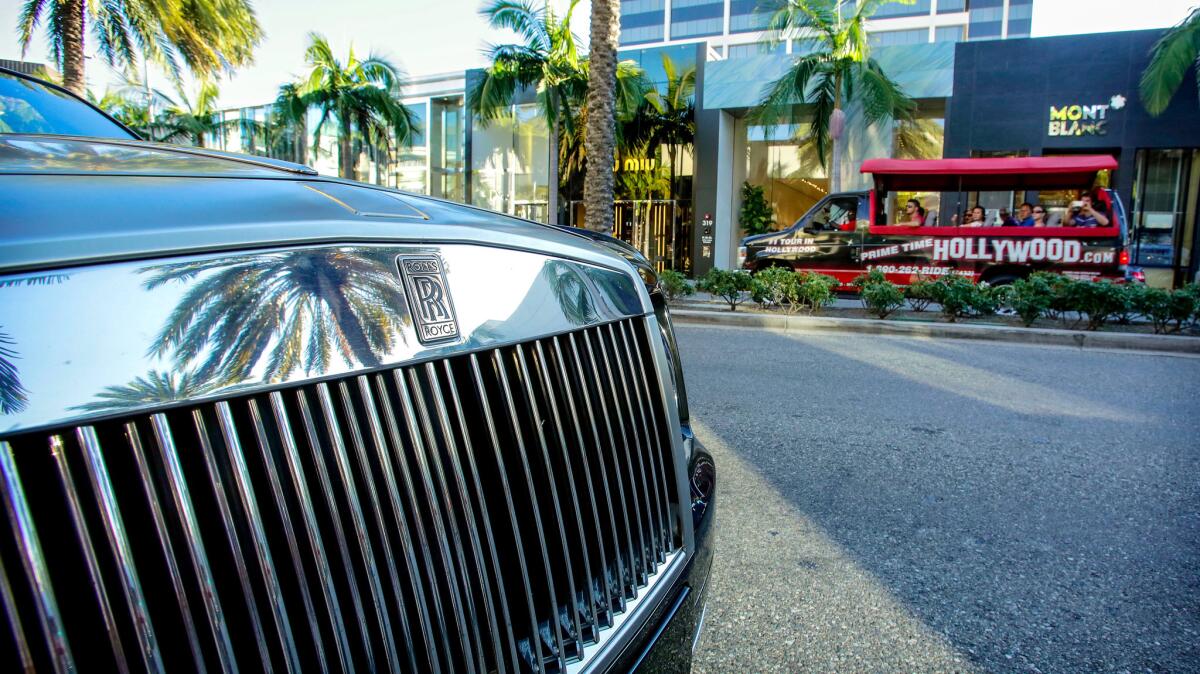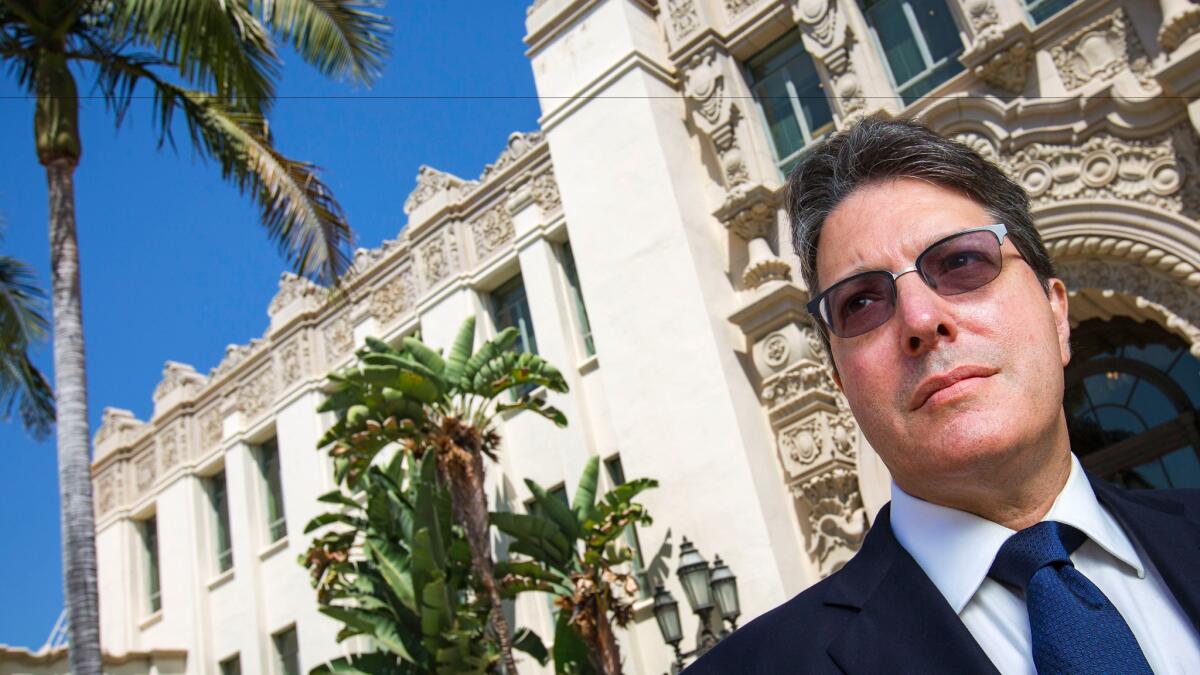Beverly Hills, land of Ferraris and Lamborghinis, seeks status as driverless-car innovator

Reporting from Beverly Hills — The ubiquitous Ferraris and Bentleys and Lamborghinis of Beverly Hills may soon be sharing the road with a new form of auto exotica: robot cars.
City leaders plan to put a robot fleet of mass transit vehicles on its roads as soon as it’s practical, aiming to make the wealthy little city of 34,000 a world leader in the early deployment of driverless vehicles.
For the record:
5:07 p.m. Nov. 7, 2024A previous version of this story said Beverly HIlls Mayor John Mirisch opposed the Beverly Hills Metro station for the new Purple line. He supported it, but did oppose the line’s extension to Century City.
“The potential of autonomous vehicles is enormous, not just for Beverly Hills, but for the entire region,” Mayor John Mirisch said.
Right now the robot fleet is more of an idea than a fully laid-out plan. But the city has taken a series of early steps, and sees itself as perfect proving ground for autonomous public transit: 5.7 square miles, a low-density population, well-marked and well-maintained streets unblemished by potholes.
The City Council in April adopted a resolution supporting driverless vehicles for public transit. The planning and information technology departments are actively developing a strategy to make it happen.
City officials are meeting with major and minor players in the field — from Google and Ford to small start-ups — inviting them to use the city’s roads as a driverless test bed.

“If you’re an innovator, test it here, put your vehicles on the roads of Beverly Hills,” said Grayson Brulte, a technology industry consultant and advisor to the municipality’s Smart City/Technology Committee.
Beverly Hills is organizing a symposium on driverless cars in January at the Wallis Annenberg Center for the Arts. A close-off of Rodeo Drive for a driverless car demonstration day is also in the works, Brulte said.
Styling itself as a technology innovator preparing for a fast-arriving future, the city in December will start laying fiber optic cable to carry super-speed Internet service into every business and home. It will be linked to the city’s traffic control system, too. Researchers, dependent on huge volumes of traffic data generated by robot cars bristling with sensors, could tap into that high-speed network to collect it.
That sounds like the right environment to Aaron Steinfeld, who researches intelligent transportation systems at Carnegie Mellon University. Driverless research today, he said, works best “in environments that are consistent and easy to perceive.”
“Worn or absent road markings, potholes, and snow or fallen leaves all create challenges,” he said. “Wide roads and low speeds can help —– it’s easier to avoid a collision if there is time and space to react.”
Autonomous public transit is an idea that has been gaining traction.
In July, Tesla founder Elon Musk announced plans for a “high passenger density urban transport” vehicle that is in the early development stages “and should be ready for unveiling next year.” The small bus would be designed without a center aisle, with seats close to the entrances, and would be able to automatically pace itself with traffic.
Another company, Local Motors, is developing a small driverless bus called the Olli.

Automakers say they don’t expect to deploy driverless vehicles for three to five years at least. Beverly Hills plans to be ready when they do. The city staff is looking at financing — public, private, or a mix. It needs to figure out fares, how routes will be chosen, and where to put “valet” zones.
“Right now we don’t know what the perfect mix of vehicles is,” Mirisch said. “Four seats? Eight seats? Twelve seats?”
If Beverly Hills builds it, though, will people ride? After all, the glitzy city is known as a place where people come to cruise the streets in their own luxury cars — not line up at the corner bus stop to ride public transit.
Proponents say demographics work in their favor. The population is older than average: The median age of Los Angeles is 35, and 36.2 across California, but in Beverly Hills, it’s 43. While 8% of Los Angeles residents are over 70, in Beverly Hills, it’s 14% — and the percentage is growing.
“They’d love to get out more,” Brulte said. “Right now a lot of them need a relative to drive them, or need to call a taxi. With an on-call [autonomous vehicle], they’ll get their freedom back.”
The new Metro rail route known as the Purple line, now under construction, provides another rationale. It will create seven stations extending west, including one at Wilshire and Rodeo, smack in the middle of Beverly Hills.
The robot fleet, Mirisch said, could provide dependable “last-mile” connections between the Metro stop and Beverly Hills homes and businesses. People could use Uber or Lyft, but a dedicated transit system could be more regular and dependable and, depending on fare structure, cheaper. Chances are, he said, the robot fleet will be operating already by the station’s planned opening date, 2023.
Mirisch fought hard against extension of the Purple line to Century City. He continues to battle plans to allow high-density residential development around the Bevery Hills station, and is actively fighting passage of Measure M on the November ballot, which would raise the sales tax to boost Metro’s budget and fund other transportation projects.
He characterizes such development as a “Big Brother” imposition on local communities, and fears places like Beverly Hills will lose their low-density character.
Autonomous vehicles, he said, will prove a more effective, less expensive way to provide public transportation than costly rail projects.
That view could be seen as self-serving, but he’s got allies in the academic community. They include James Moore of USC, who has long criticized Metro for its huge costs and meager results.
“The number of complete transit trips per capita countywide is down 33% in the last 30 years” despite billions spent on mass transit, he said.
Joel Kotkin of Chapman University insists that most Americans prefer suburban-style living, and an autonomous public transit system would suit such communities well.
“The mayor is asking the right questions,” said Kotkin, an author and fellow in urban studies. “He’s reflecting not just Beverly Hills but people in Granada Hills, people who want something of a suburban quality of life.”
Not everyone is down with the program.
The Beverly Hills Chamber of Commerce is a strong supporter of Measure M. The city may be small, but the total workforce brings the weekday population to more than 200,000 a day, says Mark Egerman, former mayor and lifelong Beverly Hills resident.
His office is a block from the new Metro station, which he said will provide a 20-minute shot downtown. Driverless cars will help people get to and from the station, he said, but so will taxis buses and Uber. “An autonomous car is still another car on the road,” he said.
Whatever the motivations and the social effects, driverless vehicles are emerging as an economic driver, and Mirisch wants Beverly Hills to be part of it.
City-states as distant as Singapore have re-geared their regulations to support driverless cars, as have such Northern California municipalities as Mountain View and Contra Costa County. In Pittsburgh, Uber has unleashed a small fleet of autonomous cars, a program it plans to expand to other cities soon.
Mirisch said cities in Southern California also need to get in gear, and fast.
“We can lag or we can lead,” he said. “If we don’t do it, other regions, other states and other countries will.”
Twitter: @russ1mitchell







